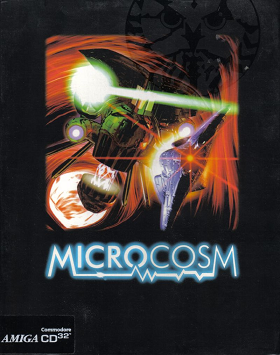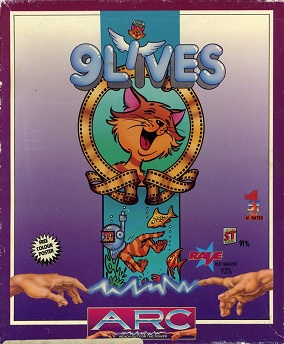
Zool: Ninja of the Nth Dimension is a platform game written for the Amiga by Gremlin Graphics and published in 1992. It was marketed as a rival to Nintendo's Super Mario and Sega's Sonic the Hedgehog. Zool was ported to other platforms and followed by Zool 2 in 1993.

Zool 2 is a side-scrolling platform video game originally developed by The Warp Factory and published by Gremlin Graphics for the Amiga in November 1993. It is the sequel to the original Zool, which was released earlier in 1992 on various platforms.

Pinball Fantasies is a 1992 pinball video game originally developed by Digital Illusions and published by 21st Century Entertainment in Europe for the Amiga home computers. It is the sequel to Pinball Dreams, which was released earlier in the same year on multiple platforms. In the game, players can choose between any of the four available playfields, both of which have their own thematic and main objectives in order to obtain the highest score possible.

Soccer Kid is a 1993 side-scrolling platform game developed and published by Krisalis Software in Europe for the Amiga. The player assumes the role of the titular main protagonist who travels across several countries around the world to repair the World Cup by retrieving pieces that were scattered by the alien pirate Scab, the main antagonist who failed to steal and add it to his trophy collection in a robbery attempt. Its gameplay mainly consists of platforming and exploration elements, with a main single-button or two-button configuration, depending on the controls setup.

Monster Business is a 1991 vertically scrolling platform game developed by Eclipse Software Design and published by Ascon that was released for the Amiga and Atari ST.

Fire and Ice: The Daring Adventures of Cool Coyote is a platform game created by Graftgold for the Amiga and the Atari ST, released in 1992 by Renegade.

Worms: The Director's Cut is an artillery strategy game, a sequel to Worms, developed by Team17 and published by Ocean Software. It was programmed by Andy Davidson and released in 1997 for the Amiga platform only.

Lionheart is a platform game for the Amiga developed and self-published by German video game developer Thalion Software in 1993. Using a fantasy motif, the game takes place in the land of the Cat People, a race of feline humanoids, who are threatened by the evil Norka. The player assumes control of Valdyn, an outlaw swordsman who is also known as "Lionheart". Players have to fight their way through 14 levels filled with monsters and environmental hazards. Most of the gameplay is melee combat and precision platforming.

Microcosm is a 3D rail shooter video game developed and published by Psygnosis in 1993. It was originally developed for the FM Towns, and ported for the Sega CD, Amiga CD32, 3DO, and MS-DOS. Microcosm featured realistic FMV animation, with the graphics being rendered on Silicon Graphics workstations. The game is either in first-person or third-person view depending on the gaming system.

Robinson's Requiem is a 1994 survival simulation video game developed and originally published by Silmarils exclusively in Europe for the Atari ST, Atari Falcon and Amiga. Taking place in the 22nd century where Earth and colonized planets are facing overpopulation, the game sees players assuming the role of Robinson officer Trepliev 1 from the Alien World Exploration department in his attempt to escape imprisonment from the fictional planet of Zarathustra alongside another AWE Robinson named Nina1, while facing several hostile creatures and dangers in order to survive.

Deliverance is a platform game developed and published by 21st Century Entertainment in 1992 for the Amiga and Atari ST, and in 1993 for Macintosh. It is a remake of the 1990 Hewson Consultants game Deliverance: Stormlord II, featuring new graphics and sound as well as a changed gameplay system and a different plot. A version for the Sega Genesis was planned but never released.

P-47: The Phantom Fighter is a 1988 horizontally scrolling shooter arcade video game originally developed by NMK and published by Jaleco. Set during World War II, players control a Republic P-47 Thunderbolt fighter aircraft to face against the Nazis, who are occupying multiple countries around the world. Its gameplay involves destroying waves of enemies, picking up power-ups and new weapons, and destroying bosses. It ran on the Mega System 1 hardware.

Brutal Sports Football is a 1993 sports video game developed by Teque London and originally published by Millennium Interactive for the Amiga. It was re-published for MS-DOS and Amiga CD32, and later became the first third-party title published for the Atari Jaguar. The first entry in the Brutal Sports series, the game is a fictional style of football played against human or computer-controlled opponents. It features a different take on american football by emphasising the violent aspect of the sport.

Kang Fu is a platform game released for the Amiga and Amiga CD32 in 1996, and is the first and only title from Dutch-based studio GREat Effects Development. The game is notable for its use of the Amiga Advanced Graphics Architecture to generate high-colour graphics through hundreds of digitized sprites from stock images.

Deathbringer is a 1991 side scrolling action game developed by Oxford Digital Enterprises and published by Empire that was released for the Amiga, DOS, and Atari ST.

Fly Harder is a multidirectional shooter developed by Starbyte Software and published by Krisalis Software. The game was originally released for the Amiga in 1993. A port for the Amiga CD32 was released in 1994.

Marvin's Marvellous Adventure is a 1994 platform video game developed by Infernal Byte Systems and published by 21st Century Entertainment for the Amiga. An Amiga CD32 version was later released in 1995. It stars Marvin, a pizza delivery boy transported into another dimension embarking on an adventure to defeat an evil being known as Dark-One and rescue a professor who ordered a pizza. The player must traverse through 60 levels and search for items and power-ups, while defeating enemies along the way.

Pinkie is a 1994 platform video game developed by Data Design Interactive and originally published by Millennium Interactive for the Amiga. A Super Nintendo Entertainment System version was released by Piko Interactive in 2018. In the game, the player assumes the role of Pinkie, who is tasked with collecting dinosaur eggs through the galaxy to prevent their extinction. The player controls Pinkie and his "Pinkie Pod" vehicle across 50 levels featuring their own variety of enemies and obstacles divided into five planets. The Pinkie Pod can perform various actions, and the player can obtain upgrades to augment its features.

X-It is a 1994 puzzle video game developed by Data Design Interactive (DDI) and published by Psygnosis for the Amiga and MS-DOS. The Amiga version was also distributed in Australia by Hot Point. The game stars a character named Bill, who was kidnapped by aliens and placed him on a space junkyard maze to learn about the humans, before launching an invasion against people on Earth. The player controls Bill across 120 levels, each one divided into eight ships that feature their own variety of obstacles. The goal on every level is to get each block into hole fillers to make a path around the exit, without getting blocks stuck against walls or other obstacles under a time limit.

9 Lives is a 1990 platform video game released for the Amiga and Atari ST developed by ARC, a software division of Atari. The player takes the role of Bob Cat, who must rescue Claudette from a mad scientist who kidnapped her.





















